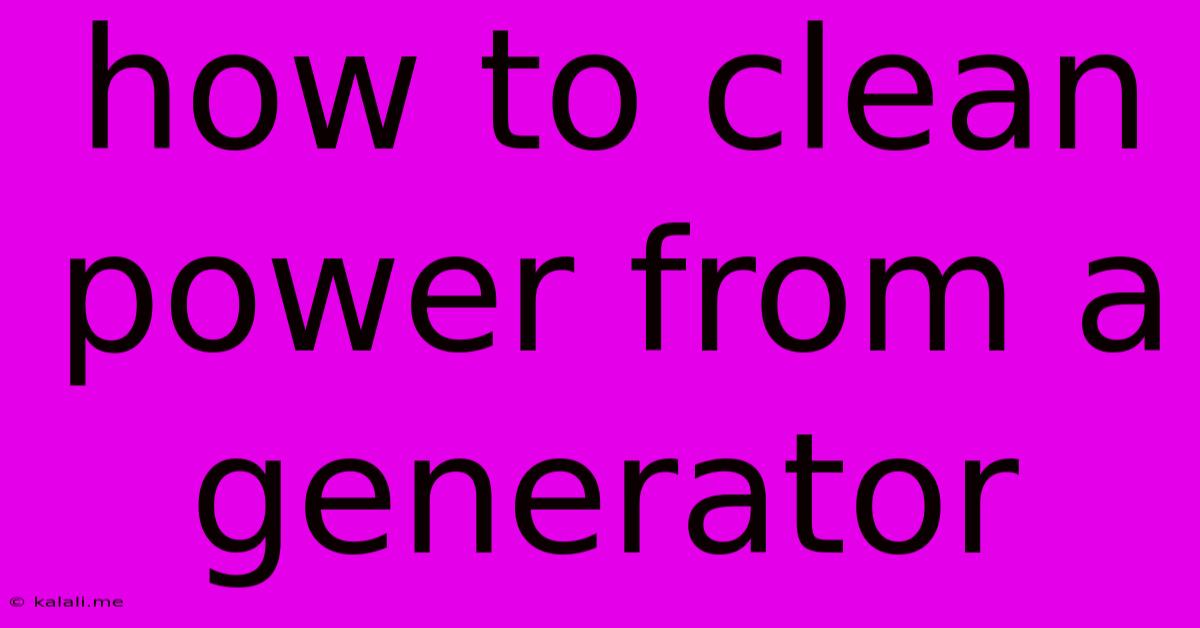How To Clean Power From A Generator
Kalali
Jun 01, 2025 · 3 min read

Table of Contents
How to Clean Power from a Generator: Ensuring Safe and Reliable Electricity
Generator power, while a lifesaver during outages, often isn't as clean as power from the grid. This means it can contain noise, harmonics, and voltage fluctuations that can damage sensitive electronics. This article explores practical methods to clean up generator power, ensuring your devices remain safe and functional. Understanding this is crucial for protecting your investment and preventing costly repairs.
Understanding Generator Power Impurities
Before diving into cleaning methods, it's essential to understand why generator power needs cleaning. Traditional generators produce power through a process that inherently introduces imperfections. These include:
- Harmonics: These are unwanted frequencies that are multiples of the fundamental frequency (typically 50Hz or 60Hz). They create distortions in the sine wave, leading to overheating and malfunctions in electronics.
- Noise: This refers to random voltage fluctuations, often caused by mechanical issues within the generator itself. Noise can disrupt sensitive equipment and even lead to data loss.
- Voltage Fluctuations: Inconsistent voltage output, either undervoltage or overvoltage, is another common issue. This can damage components by causing them to operate outside their rated specifications.
- Transient spikes: Sudden, brief surges in voltage can be extremely damaging to electronic devices.
Methods to Clean Generator Power
Several methods can effectively mitigate these impurities and provide cleaner power to your devices:
1. Using a Power Conditioner: This is the most effective and recommended method. Power conditioners are specifically designed to filter out noise, harmonics, and voltage fluctuations. They act like a buffer, stabilizing the power output from the generator. Look for conditioners with features like:
- AVR (Automatic Voltage Regulator): Maintains a consistent output voltage despite variations in the generator's output.
- Surge Protection: Protects against transient voltage spikes.
- Line Filtering: Removes harmonics and noise from the power supply.
2. Employing a UPS (Uninterruptible Power Supply): While primarily known for backup power, many UPS systems also include voltage regulation and surge protection capabilities. This offers a degree of power cleaning, although not as comprehensive as a dedicated power conditioner. This is a good option if you already have a UPS system in place.
3. Using a Generator with Built-in Power Cleaning Features: Some modern generators incorporate features to improve power quality directly. Check the specifications of your generator to see if it offers features like voltage regulation or harmonic mitigation.
4. Isolating Sensitive Equipment: For less sensitive devices, consider a less powerful approach. Power strips with surge protection can offer basic protection against surges and some noise. For highly sensitive electronics, consider powering them from a separate, cleaner power source like a battery backup.
Choosing the Right Solution
The best method for cleaning generator power depends on several factors:
- Budget: Power conditioners are typically more expensive than UPS systems or surge protectors.
- Sensitivity of Equipment: Highly sensitive electronics require more sophisticated protection.
- Power Requirements: Consider the wattage and power demands of the equipment you plan to power.
Remember, a clean power supply is crucial for protecting your valuable electronics and ensuring their longevity. Don't risk damage – invest in a suitable power cleaning solution based on your specific needs.
Maintenance and Best Practices
Beyond cleaning the power, proper generator maintenance plays a crucial role in power quality:
- Regular servicing: Ensuring your generator is well-maintained reduces the likelihood of producing noisy or fluctuating power.
- Proper fuel: Using the correct type and quality of fuel is essential for optimal generator performance.
- Stable load: Avoid overloading the generator, as this can contribute to voltage instability.
By understanding the sources of power impurities and employing the appropriate cleaning methods, you can ensure your equipment remains safe and functional, even when relying on generator power. Remember, proactive measures are key to preventing costly repairs and downtime.
Latest Posts
Latest Posts
-
How Early Should You Arrive To A Basketball Game
Jun 02, 2025
-
Notch In The Belt Or On The Belt
Jun 02, 2025
-
Initiating Processes Take Place During Each Phase Of A Project
Jun 02, 2025
-
Can Ground Beef Be Cooked From Frozen
Jun 02, 2025
-
Did Any Of Jesus Disciples Have Gets Married
Jun 02, 2025
Related Post
Thank you for visiting our website which covers about How To Clean Power From A Generator . We hope the information provided has been useful to you. Feel free to contact us if you have any questions or need further assistance. See you next time and don't miss to bookmark.